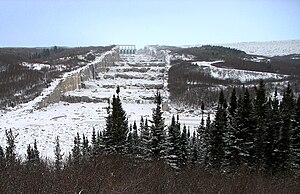
Back Baie-James-Wasserkraftprojekt German Proyecto de la bahía de James Spanish Projet de la Baie-James French Džeimsa līča projekts Latvian/Lettish Залив Джеймс (проект) Russian James Bay-projektet Swedish Затока Джеймс (проєкт) Ukrainian Dự án thủy điện vịnh James Vietnamese

The James Bay Project (French: projet de la Baie-James) refers to the construction of a series of hydroelectric power stations on the La Grande River in northwestern Quebec, Canada by state-owned utility Hydro-Québec, and the diversion of neighbouring rivers into the La Grande watershed. It is located between James Bay to the west and Labrador to the east, and its waters flow from the Laurentian Plateau of the Canadian Shield. The project is one of the largest hydroelectric systems in the world. It has cost upwards of US$20 billion to build[citation needed] and has an installed generating capacity of 15.244 GW, at the cost of 7,000 square miles of Cree hunting lands.[1] It has been built since 1974 by James Bay Energy (SDBJ) for Hydro-Québec.
Construction costs of the project's first phase in ≈ 1971 amounted to $13.7 billion (1987 Canadian dollars).[2] The eight power stations of the La Grande Complex generate an average of 9.5 GW, enough to meet the total demand of a small industrialized economy such as Belgium.[3] The James Bay power stations represent almost half of Hydro-Québec's total output and capacity.
The development of the James Bay Project was controversial. It led to an acrimonious conflict with the 5,000 Crees and 4,000 Inuit of Northern Quebec over land rights, lifestyle and environmental issues. A ruling against the Quebec government in 1973 forced the Robert Bourassa government to negotiate a far-reaching agreement, the James Bay and Northern Quebec Agreement, involving the Cree, the Inuit, the Quebec and Canadian governments, Hydro-Québec, the SEBJ, and later the Naskapi First Nations. In the 1990s, forceful opposition by the Crees and their environmental allies caused the cancellation of the Great Whale Project, a proposed 3,000 MW complex north of La Grande River.[4]
In February 2002, the Bernard Landry government and the Grand Council of the Crees signed the Peace of the Braves (French: Paix des Braves) and the Boumhounan Agreement, establishing a new relationship between Quebec and the Crees and agreeing on environmental rules for the construction of three new power stations built between 2003 and 2011 — the Eastmain-1, Eastmain-1-A and Sarcelle generating stations — and the diversion of the Rupert River.
- ^ Pritzker, Barry (1999). Native America Today: A Guide to Community Politics and Culture. ABC-CLIO. ISBN 978-1-57607-077-2.
- ^ Société d'énergie de la Baie James 1987, p. 11
- ^ Government of Quebec 2006, p. 10
- ^ https://waskaganish.ca/the-james-bay-project/